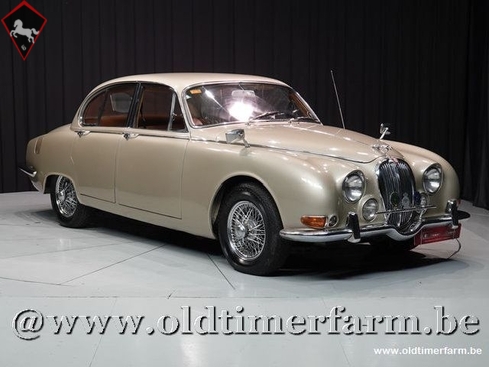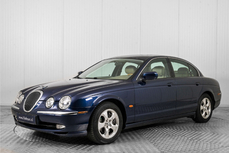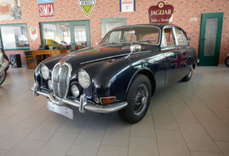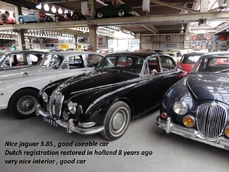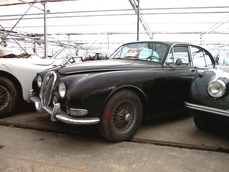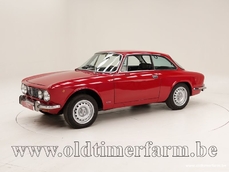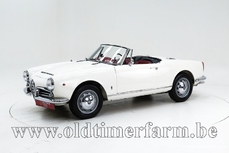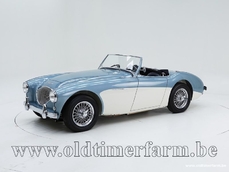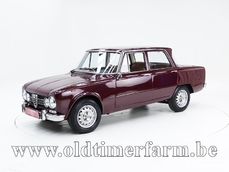Jaguar S-Type 3.8 Litre Saloon Auto '67 1967
General description :
Belgian papers.
Bought by the current owner in 2010. Since then the car has been hardly driven.
Clean presentation, whopper of an engine 3.8 Liters!
Regularly maintained in the past but due to the long period of inactiveness the car needs a big maintenance including: revision brakes and steering, liquids etc.
Is sold as is in its current condition without technical control.
The Jaguar S-Type wad produced from 1963 to 1968. It was a technically more sophisticated development of the Mk 2, offering buyers a more luxurious alternative without the size and expense of the Mark X. The S-Type sold alongside the Mark 2, as well as the Jaguar 420 following its release in 1966.
The S-Type was a major redevelopment of the Mark 2. It used a mid-scale version of the Mark X independent rear suspension to replace the Mark 2's live rear axle and featured longer rear bodywork, among other styling and interior changes. The S-Type was available with either 3.4 or 3.8-litre XK engines but only in twin carburettor form because the triple carburettor setup would not fit into what was essentially still the Mark 2 engine bay.
By the time of the S-Type's release in 1963, the Mark 2 remained an unexpectedly strong seller despite its age. Although the Mark X was selling less well than hoped, especially in its intended market of the USA, Sir William decided to retain all three models in the Jaguar range concurrently. The Mark X was renamed "420G" in 1966 and was joined by another new model, the 4.2-litre 420. The 420 was developed to replace the S-Type but because some demand remained for the S-Type, all four saloon models (Mark 2, S-Type, 420 and 420G) remained on sale until the arrival of the Jaguar XJ 6 in 1968. The XJ6 replaced all but the 420G in the Jaguar range.
Specifications
Bodywork
Length : cm (in): 477 (187.8)
Width : cm (in): 170 (66.7)
Height : cm (in): 138
Wheelbase : cm (in) : 273 (107.4)
Weight: kg (lb) : 1700 (3748)
Mechanics.
Displacement : straight six 3781 cc (231 cu in), front-mounted
Valve gear : 12
Fuel system : 2 SU carburettors
Gearbox : 3-speed automatic
Drive wheels : rear-wheel drive
Maximum power : 220 hp at 5500 rpm
Maximum torque : 334 Nm at 3000 rpm
Maximum speed : 195 km/h (121 mph)
http://www.oldtimerfarm.be/en/collection-cars-for-sale/3988/jaguar-s-type-38-litre-saloon-auto-67.php
1967 Jaguar S-Type 3.8 Litre Saloon Auto '67 is listed sold on ClassicDigest in Aalter by Oldtimerfarm Dealer for €14950.
Car Facts
Car type : Car Make : Jaguar Model : S-Type Model Version : 3.8 Litre Saloon Auto '67 Engine size : 0.0 Model Year : 1967 Location : Aalter
Sold
Seller Information
Sold
People who viewed this Jaguar S-Type also viewed similar Jaguar listed at ClassicDigest
Other cars listed for sale by this dealer
About Jaguar
Ah, the story of Jaguar, from its early days as the SS Cars Ltd. to its pinnacle with the D-type, and the street-going evolution in the form of the iconic E-type. There's something quintessentially British about this tale, and I'll narrate it as a British journalist might.In the Beginnings:
Our journey into the world of Jaguar begins in the 1930s, when a company known as SS Cars Ltd. emerged. Despite the unfortunate coincidence of their initials with the rising political tensions in Europe, they started producing stylish and performance-oriented cars. The SS 100, introduced in 1936, was a symbol of elegance and speed, setting the stage for what would become Jaguar.
The Birth of Jaguar:
As the shadows of World War II loomed, SS Cars Ltd. wisely decided to disassociate themselves from the SS initials. Thus, in 1945, they officially became Jaguar Cars Ltd., a name that would soon be synonymous with British luxury and performance.
The XK Series:
Jaguar's post-war era brought us the XK 120, a true sensation in 1948. With its sleek design and a powerful 3.4-liter inline-six engine, it became the world's fastest production car. The XK 120 was the blueprint for what lay ahead – Jaguars that blended style with speed in a uniquely British fashion.
The D-type Dominance:
Then came the D-type, a true racing legend. Introduced in 1954, it won Le Mans three times in the 1950s, showcasing Jaguar's engineering prowess. With its innovative monocoque construction and the iconic fin at the back, the D-type was the apex of Jaguar's motorsport success.
The E-type Emergence:
But the true turning point arrived in 1961 with the introduction of the E-type, often described by Enzo Ferrari as "the most beautiful car ever made." Its long bonnet, curvaceous body, and a 3.8-liter engine delivering exhilarating performance made it an instant classic. The E-type was not just a car; it was a work of art on wheels, and it could hit 150 mph on the road.
Street and Racing Success:
The E-type's beauty was matched by its capability on the track. The lightweight E-types were particularly successful in various racing events, cementing Jaguar's reputation as a force to be reckoned with in motorsport.
The Age of Refinement:
As we delve deeper into the Jaguar story, we find that the 1950s and 1960s were an age of refinement and expansion. Alongside the magnificent D-type and the E-type's iconic emergence, Jaguar introduced models that further solidified its reputation for luxury and performance.
The MK2:
In the late 1950s, Jaguar unveiled the MK2, a sports sedan that combined elegance with power. This sleek four-door saloon was a favorite of bank robbers and law enforcement alike, thanks to its exceptional speed and handling. The MK2 was a symbol of Jaguar's ability to blend sophistication with performance and had a successful racing career as well.
The XJ6:
Fast forward to 1968, and Jaguar launched a car that would define luxury saloons for decades to come – the XJ6. It was a masterpiece of engineering and design, featuring a smooth inline-six engine, independent rear suspension, and a spacious, beautifully appointed interior. The XJ6 was a symbol of British elegance and provided a ride so smooth that it seemed to glide over the road. It became the flagship model for Jaguar and set the standard for luxury saloons, showcasing a level of refinement that left competitors in awe.
The Blend of Classic and Modern:
While the MK2 and XJ6 represented the evolution of Jaguar's saloon cars, they maintained the brand's commitment to performance and luxury. These cars didn't just belong on the racetrack; they were equally at home cruising down the grand boulevards or gliding through the English countryside.
The Challenges of Change:
However, as the 1970s arrived, Jaguar, like many British automakers, faced financial challenges and changes in ownership. The British Leyland era brought both opportunities and struggles, as the brand navigated through various mergers and transitions.
Nevertheless, the legacy of the MK2 and XJ6, along with the D-type and E-type, continues to define Jaguar as a manufacturer that combines timeless elegance with a spirit of performance. These classic models, whether driven on winding roads or parked as collectors' treasures, serve as a testament to Jaguar's enduring presence in the world of automotive excellence.
The Jaguar story, from its early days as SS Cars Ltd. to the creation of automotive icons like the E-type, MK2, and XJ6, is a journey that reflects the very essence of British motoring – a blend of luxury, power, and style that continues to captivate enthusiasts and connoisseurs alike.
